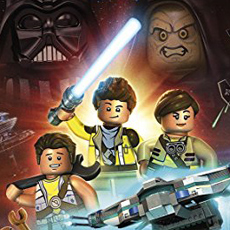Lucasfilm Animation (2014), Beuna Vista Home Entertainment (November 11, 2014), 2 Discs, 287 mins, 2.39:1 ratio, Dolby Digital 5.1, Rated TV-PG, Retail: $45.99
Storyboard:
As the Clone Wars become more desperate for the Republic, Darth Sidious moves towards his sinister end game.
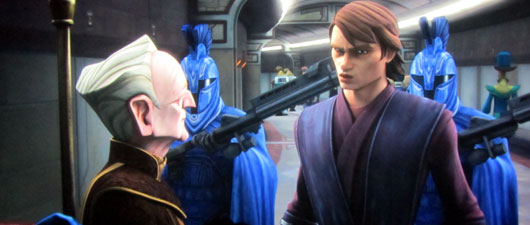
The Sweatbox Review:
The mystique of the Clone Wars has fed the imagination of countless Star Wars fans since the original film first came out in 1977. It was simply a casual reference during a conversation between Luke Skywalker and Obi-Wan Kenobi, but it implied a hidden history of the galaxy. At least, it was hidden from fans, who clamoured to know more of the mysterious but all-important event. The mystery was finally solved for fans in 2002’s Star Wars – Episode 2: Attack Of The Clones, when we found out that the clones were soldiers for the Republic, though their actual origins were still a bit of a mystery. The clones were obviously a key part of a plan by Chancellor Palpatine, the future Emperor, as it was apparent that these clones would later become the Empire’s stormtroopers.

Prior to the release of Episode 3, George Lucas decided to allow further light to be shed on the events of the war, since the theatrical film series would only deal with the beginning and the end of the war. This became the television “micro series” Star Wars: The Clone Wars, directed by Genndy Tartakovsky of Samurai Jack fame. Genndy’s series directly led into Episode 3: Revenge Of The Sith, and for a time fans thought that this was all we would see of the Clone Wars outside of novels and comic books.
However, Lucas had a grand surprise. He okayed the development of a full series that would chronicle the Clone Wars, over the course of about 100 episodes. And, while Tartakovsky’s series had been popular and award winning, the new series would not involve him, and instead would be an ambitious CGI-animated series. Fans’ excitement waned considerably when they saw the initial result, as a theatrical film serving as the series’ pilot received dismal reviews and was criticized for its sub par graphics and animation, particularly when it came to the puppet-like depictions of its human characters. Personally, I thought the direct-to-video Barbie movies handled people better.

But the best was yet to come! Over the course of five seasons, the TV series debuted well and only got better. Animators began to handle the characters better, and the character models were eventually given more complex abilities for expression. The visuals, while not quite film quality, were nevertheless extremely impressive, ranging from gorgeous planetscapes to awe-inspiring space battles. The stories explored many facets of the Star Wars universe, and did so with superbly engrossing plotting, complex characterizations, and mad imagination. In short, it was the Star Wars show we always dreamed of. I even got used to the puppet-looking characters, who Lucas has reportedly said were intentionally inspired by Gerry Anderson’s Thunderbirds.
There seemed to be no end to what the show could accomplish, but production of the series was closed down after the fifth season, due to the acquisition of the Star Wars franchise by Disney. As we all know, Disney’s focus was to be on moving the saga forward, including a new series of films set after Episode 6: Return Of The Jedi. Of course, Disney was also interested in outright owning any future spin-offs, and that meant that the Warner-distributed Clone Wars was no longer a priority. Still, rumors persisted that further episodes had been worked on, and eventually it became known that a further batch had been completed, outside the Warner deal, and thus another 13 episodes showed up when the series came to the streaming service Netflix in March of 2014.
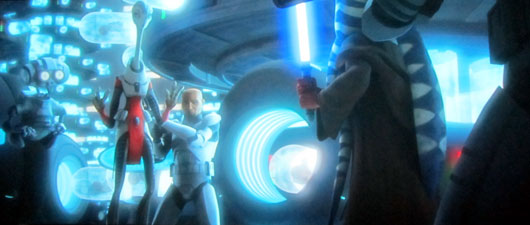
These final 13 episodes have now been released on DVD and Blu-ray. With Warner still owning distribution rights to the first five seasons, Disney has chosen not to call this “Season 6,” instead choosing to give the home video release the title The Lost Missions. No matter, though, as the series continues to explore the Clone Wars era fairly chronologically, delving into the widening divide between Anakin and Padme, and revealing more about Order 66, and even more about the nature of the Force itself.
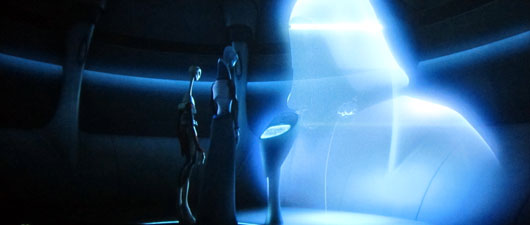
The first arc of the de facto sixth season of Star Wars: Clone Wars examines the mysterious Order 66 and how it came to be introduced to the clones. In The Unknown, clone trooper Tup seemingly goes crazy during a mission and kills a Jedi Master. Tup is brought back to his birthplace on Kamino for examination, and Anakin Skywalker is surprised to find the Separatists taking an unusual interest in Tup’s apparent mental illness. The mystery deepens in Conspiracy, as ARC Trooper Fives, while attending to his friend Tup on Kamino, becomes suspicious of Tup’s doctor and her made-up diagnosis of Tup’s condition. It may be up to Fives to disobey orders if he is going to save Tup from being exterminated.
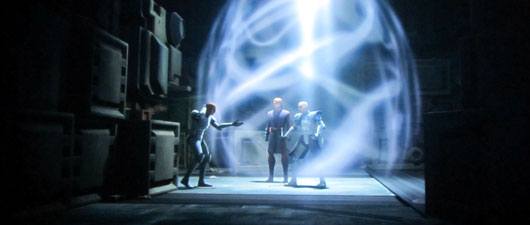
Fives gets closer to the truth in Fugitive, when he discovers that an organic construct in every clone may be responsible for Tup’s behavior. This would seem to have immense consequences for all clones, and perhaps the galaxy. Fives eventually takes his concerns directly to Chancellor Palpatine in Orders, not knowing just how far up the conspiracy goes. After being accused of trying to assassinate the chancellor, Five’s life is put in grave jeopardy, and no one is ready to hear him out, forcing him to lead a chase on Coruscant. The fate of the galaxy hinges on whether Fives can get anyone to listen to him!

An Old Friend opens up an arc featuring Rush Clovis, a former member of the Galactic Senate. Aside from now being considered a traitor to the Republic, he incurs Anakin’s wrath because Clovis was at one time romantically linked to Padme Amidala, now Anakin’s secret wife. Clovis enlists Padme’s help in obtaining incriminating evidence against the Banking Clan, after which they take the evidence to Coruscant. The Rise Of Clovis sees Clovis put in charge of the Banking Clan, but Anakin still cannot trust him. These suspicions threaten to drive Anakin and Padme further apart, and Anakin’s anger grows. By Crisis At The Heart we can see that Clovis is himself a pawn in a game set up by Palpatine and Count Dooku, and Clovis becomes the latest tragic character to see his idealism backfire on him. Though it appears that Anakin had good reason to distrust Clovis, the damage to his relationship to Padme may never heal.

No one probably thought we would ever see a “team up” story with Jar Jar Bonks and Mace Windu, nor a Jar Jar romance story, but that is the premise for The Disappeared, Part Iand The Disappeared, Part II. Jar Jar is asked by an old friend to come and investigate the vanishing of a world’s top spiritual leaders. Mace must take a back seat to Jar Jar, as that world has distrust of the Jedi, much to the chagrin of Mace. While aiding his beloved Queen Julia, Jar Jar and Mace end up fighting a mystical cult.
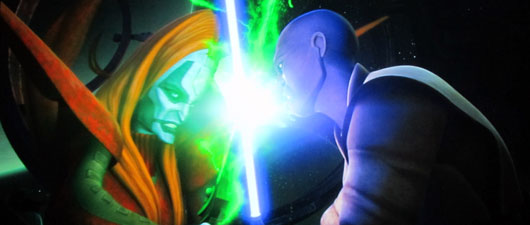
The Lost One examines the mystery of how the Clones were created in the first place, looking closer at the story of the man who placed the clone order, Jedi Master Sifo-Dyas. The Jedi investigation begins because of a found lightsaber, and leads to a confrontation with Darth Tyranus, who is acting on the orders of Darth Sidious to clean up any loose ends in the ancient conspiracy. Several revelations are made, but Sidious manages to continue to hide his identity from the Jedi.
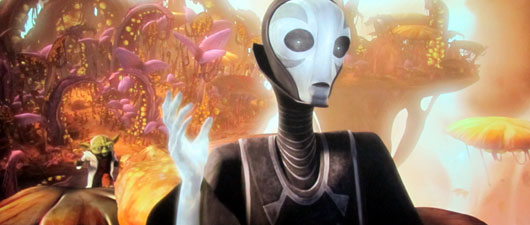
The final story arc concerns Yoda being contacted by the spirit of Qui-Gon Jinn, and told he must learn the secret of maintaining identity after death, without joining the greater Force. Even Yoda is not certain if this is possible, and he hides the true nature of his communications from his fellow Jedi in Voices, making them consider whether Yoda has fallen towards the Dark Side. Destiny sees Yoda leave Coruscant to travel to a far-off world, where he encounters five priestesses of the Force. Yoda then goes to an ancient Sith world to face true evil in Sacrifice.
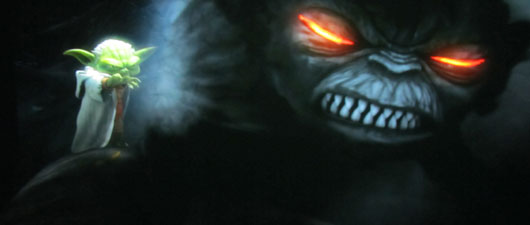
This is a very strong season for the show, as there seems to be an intentional focus on strengthening the mythology of Star Wars and bringing things to a boil before everything hits the fan in Episode 3. We have the origins of Order 66, the origins of the clones themselves, Palpatine’s seizure of the Banking Clan, and two stories that further examine the nature of the Force and how it is perceived. As for this latter point, I prefer the Jar Jar/Mace story to the Yoda one, as Yoda’s tale tries a little too hard to examine the force’s mysteries, and that’s how we ended up with the reviled midichlorians of Episode 1, after all. Still, even the Yoda arc has some fascinating concepts and solid storytelling.
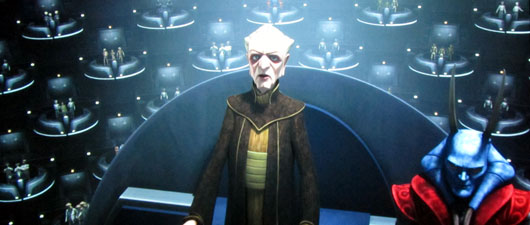
Regardless, every episode in this set is worthy of the Star Wars brand. As a whole, this entire series fleshed out the prequels immensely, and even makes them better. The machinations of Palpatine, the descent of Anakin, and the mysteries concerning the Clones come into much greater focus here than they could in the films, and with much better acting to boot (most particularly Anakin, who is extremely well played by Matt Lanter)!
Is This Thing Loaded?
The Clone Wars Declassified (16:02) is a nifty featurette that examines the show from inception to how it evolved over the course of six seasons. We see story meetings with George Lucas, and hear interviews with supervising director Dave Filoni, head designer Killian Plunkett, and others.

Four Unfinished Story Reels (1:31:21) encompass the Utapau arc, a story that was under development when the show was cancelled. This is presented in the rough animation/layout stage, and therefore includes dubbing and a complete story featuring Anakin and Obi-Wan that runs over 90 minutes, a great bonus for fans. The story brings back the concept of the Force-focusing Kaiburr crystals, first introduced in the very first Star Wars spin-off, the novel Splinter Of The Mind’s Eye.

Sneak Peeks offered from the first disc’s menu include those for Star Wars Rebels, Big Hero 6, and Maleficent.

Case Study:
Despite the green band across the cover slip, the Blu-ray case is the standard blue color. The cover slip is tastefully embossed, with a removable sticker describing the bonus features. The case holds a disc on each side, and there are inserts for Disney Movie Rewards and the Disney Movie Club. Unlike the Warner sets of previous seasons, there is unfortunately no episode guide or booklet.
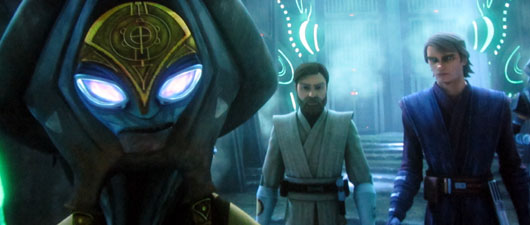
Ink And Paint:
This show was made for Blu-ray. The beautiful planetscapes, detailed hardware, and impressive special effects come to life in true high definition, more vivid and sharper than what you can see on Netflix. The image on disc, as on Netflix, is 2.39:1— just as the Warner seasons were on disc (unlike the Cartoon Network showings of earlier seasons that were normally in 16:9). The richly saturated colors are simply magnificent to behold.

Scratch Tracks:
Yikes, Disney drops the ball here, presenting episodes only in Dolby Digital 5.1, eschewing a preferred lossless audio standard. The sound — I must admit— is still pretty wonderful, with plenty of bass and great surround effects and separation; but we know how much crisper yet is would be in DTS-HD Master Audio, which is how we got the show on Warner’s previous season sets.
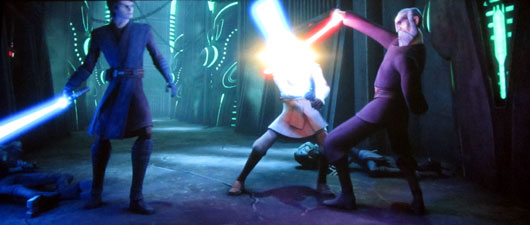
French, Spanish, and German 5.1 Dolby Digital tracks are also available. There are English, French, and Spanish subtitles, plus English captions for the hearing impaired.
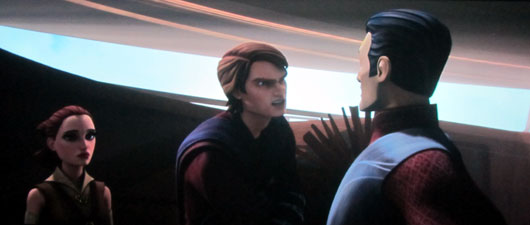
Final Cut:
Any Star Wars fan who skipped this show because they didn’t like the designs, thought it was “only a cartoon” or maybe hated the pilot film has really missed out. These stories are canon for Star Wars and actually do the mystical trick of making the prequels much, much better, simply by giving them context. With this show, one can see what Lucas was trying to do in the prequels, only to be defeated by his poor dialog, over reliance on special effects, and lack of skill directing actors. Fans who have dismissed Lucas need to see this show, a show that he guided, to see that he is still a gifted storyteller, only with some unfortunate weaknesses when he tries to do too much himself. Supervising Director Dave Filoni looks to be the hero here, as he took concepts from Lucas and many talented writers, and moulded a series that has enhanced the franchise immeasurably. This show feels like Star Wars in ways the prequels usually didn’t to me. This season doesn’t have the immense space battles that other seasons did, but there are wonderful characters, intriguing concepts, and loads of imagination, with artistry unsurpassed on television— or film, for that matter. I thank the creators of Star Wars: Clone Wars for recapturing the magic that made us all fall in love with the franchise.
 | ||
 |





